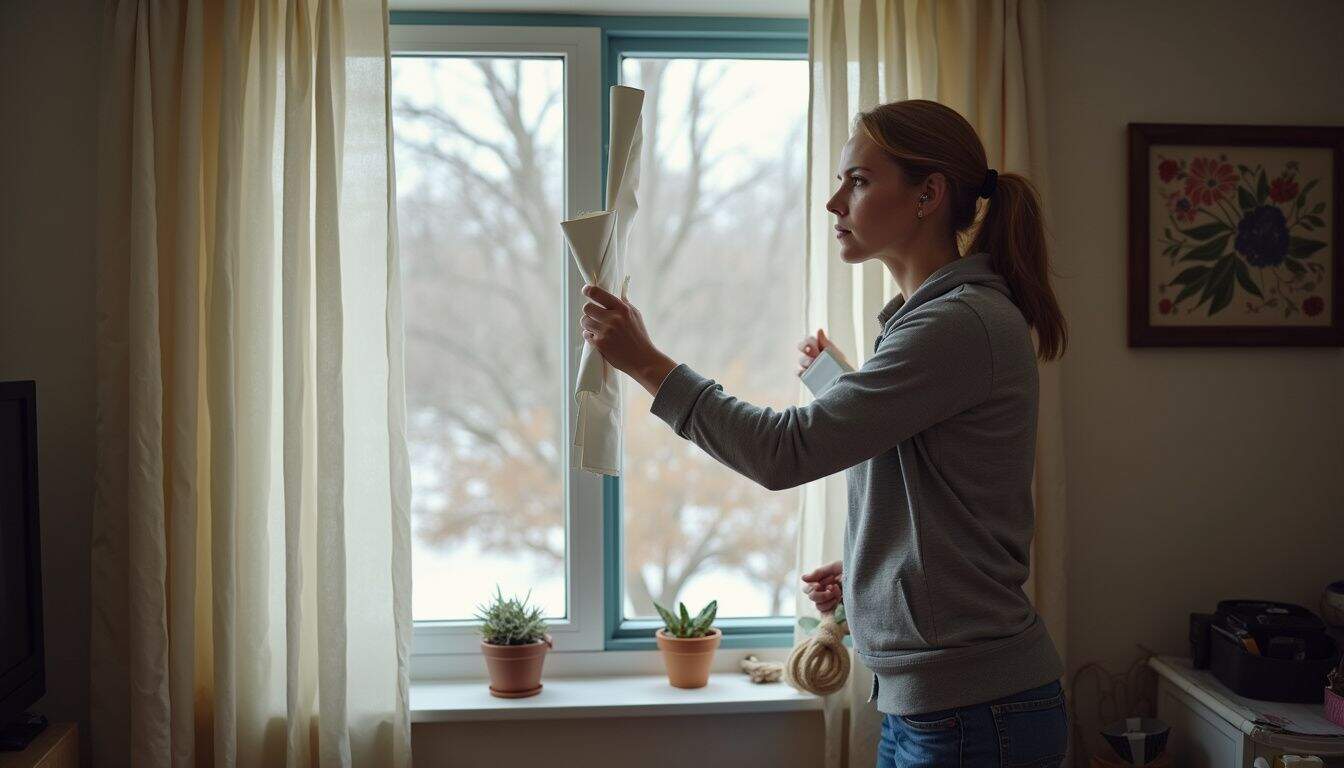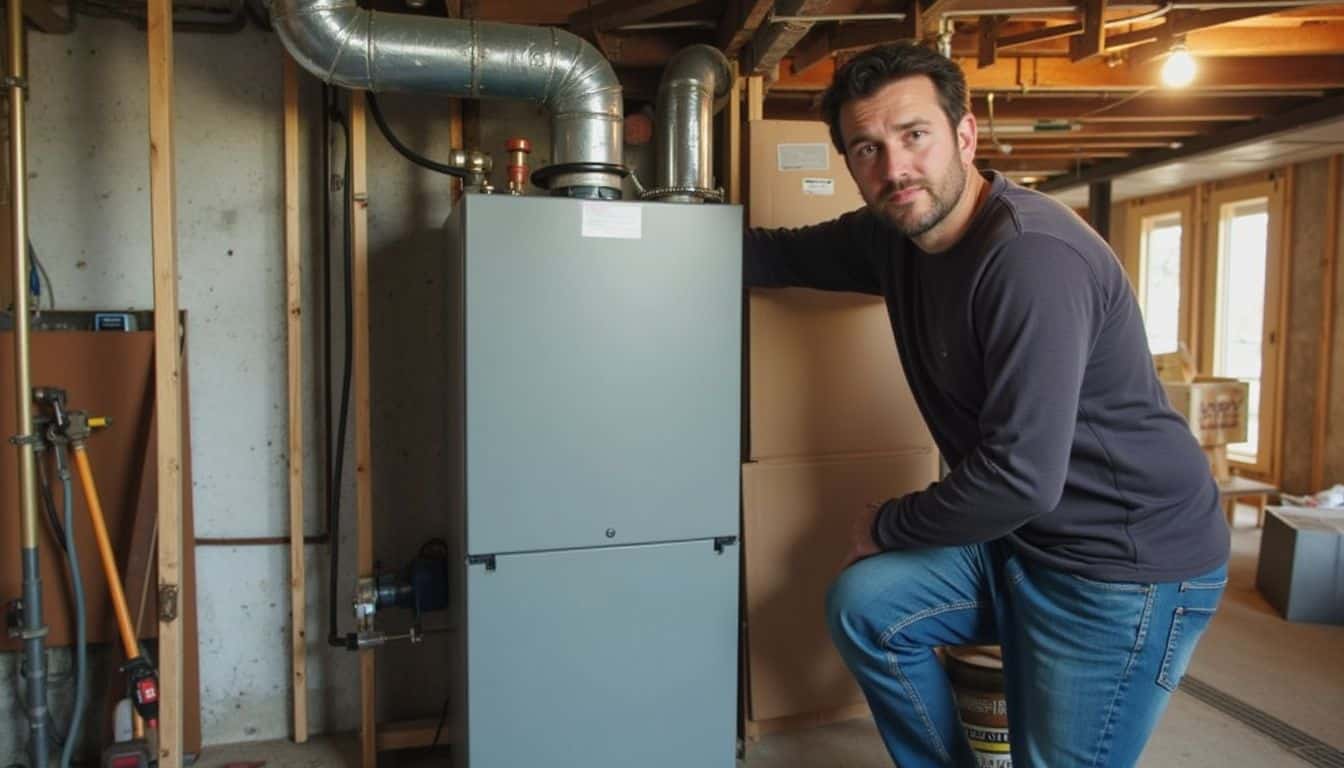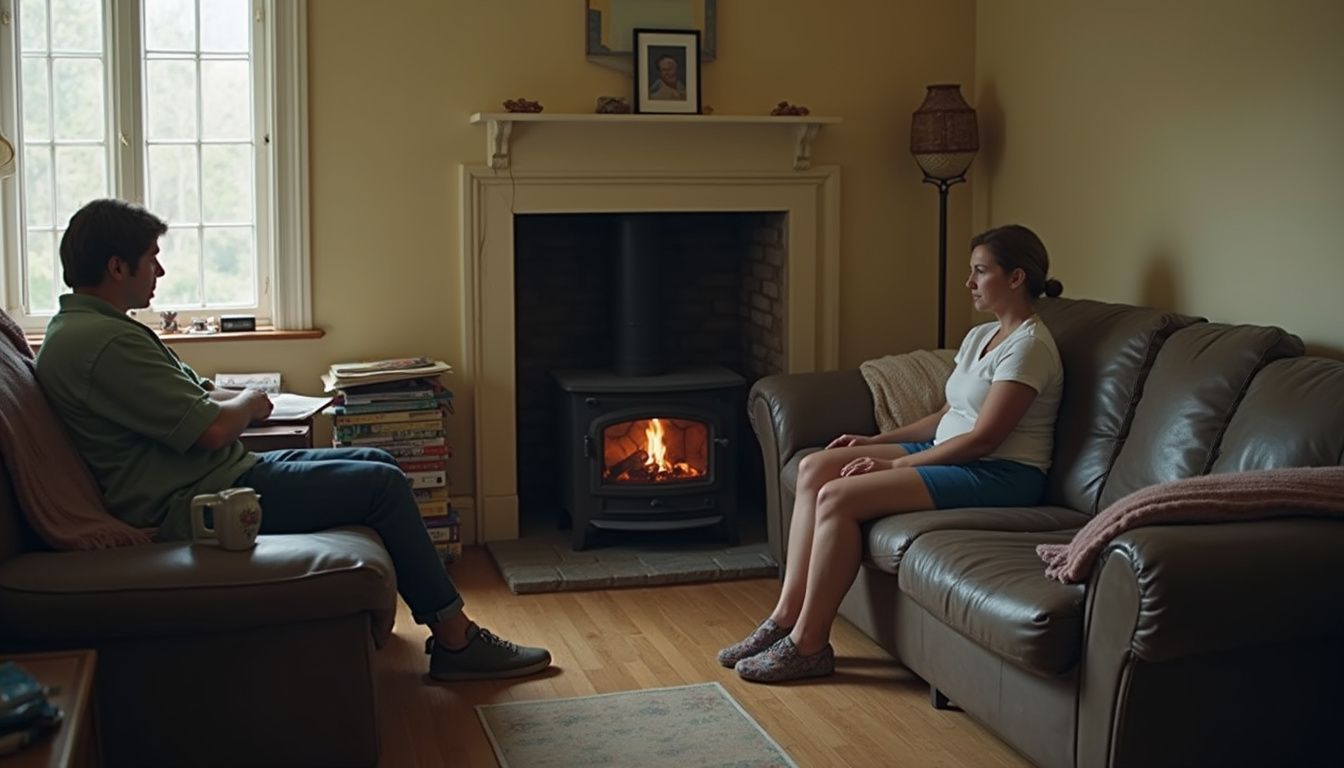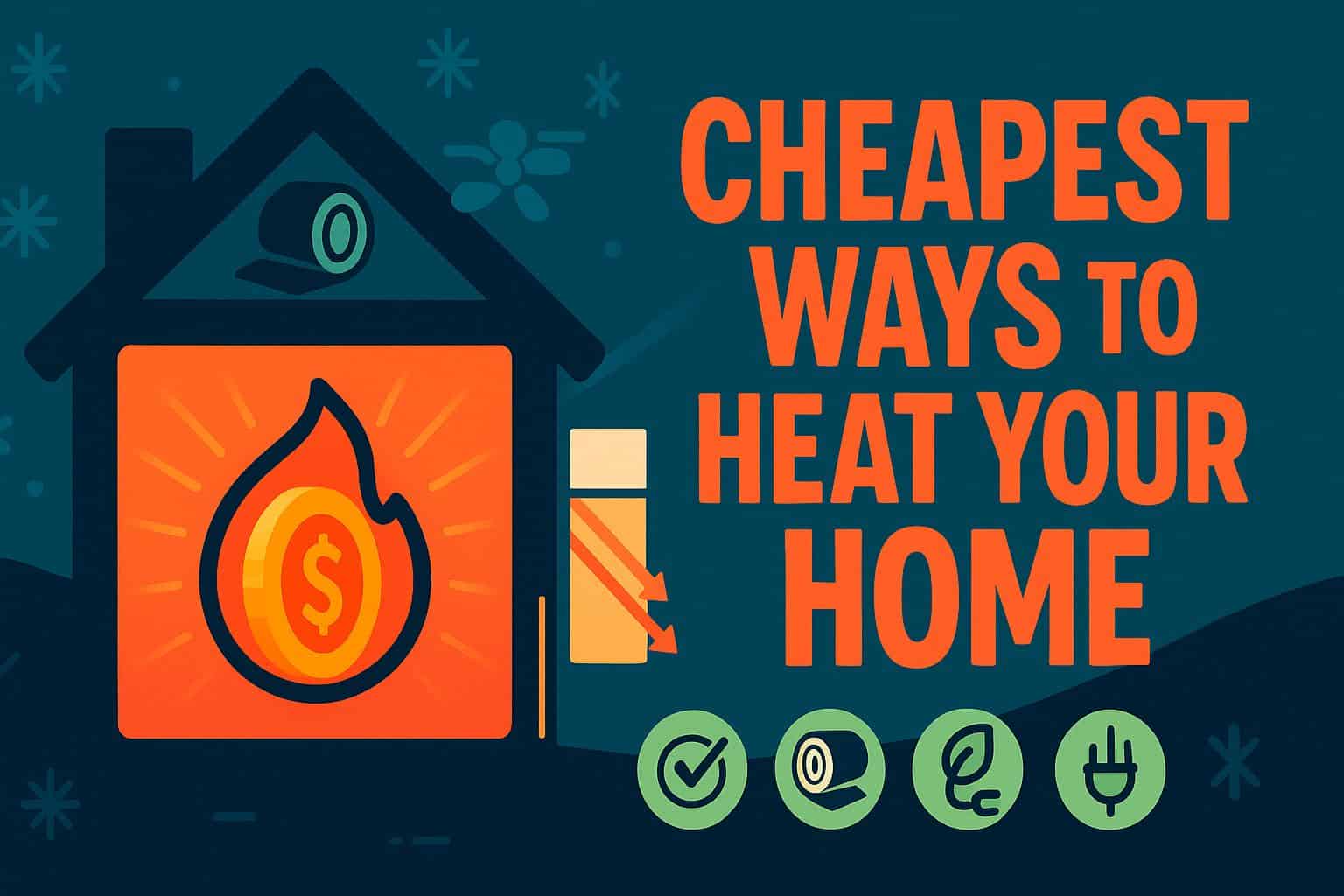Does the thought of your winter heating bill make you want to curl up under a blanket and not come out until spring?
If you feel like you’re just burning money to stay warm, I get it. We’ve all been there.
It’s kind of wild to think that about 55% of a typical U.S. household’s electricity bill goes straight to heating and cooling. That’s a huge chunk of our budget just to keep our toes from turning into icicles. With costs always changing, making smart choices about your home is more important than ever.
I’m going to walk you through some of the cheapest ways to heat your home, from simple tricks and smart tech options to bigger upgrades that can really pay off. We’ll look at how to use things you already have, seal up pesky drafts, and even lower your carbon footprint while staying cozy.
These fifteen tips will help you see a real difference in your bills. Ready to shiver less and save more? Let’s get started!
Key Takeaways
Sealing drafts around windows and doors with weatherstripping, caulk, and heavy curtains can reduce heat loss and lower heating bills; the U.S. Department of Energy says air leaks can account for up to 30% of heating loss. Adding attic insulation may cut energy costs by another 15% (EPA) and boost home resale value.
Installing energy-efficient systems like an air-source heat pump or a natural gas furnace (which can reach over 95% efficiency) can drop heating bills by 30-40%. Hybrid systems that combine both can offer even more savings in mixed climates.
Smart thermostats from brands like Google Nest or ecobee can help cut heating bills by an average of 10% and improve efficiency. They also allow you to control your heat and track usage right from your phone for easier budgeting.
Using targeted heaters, like a space heater for a small office or an infrared heater for a reading nook, prevents you from wasting electricity heating the whole house. A typical 1,500-watt space heater costs about 26 cents per hour to run, making it great for focused warmth.
Federal incentives for 2025 under the Inflation Reduction Act include a 30% tax credit, with up to $2,000 for a heat pump installation. These programs make big upgrades more affordable and can help you switch to cleaner energy sources like solar thermal panels or geothermal heat pumps.
Table of Contents
Find the Cheapest Ways to Heat Your Home by Optimizing Heat Retention

A friend of mine patched up all her window drafts with some basic foam tape and said her living room finally felt cozy for the first time all winter. It’s amazing what a few small fixes can do. Even simple things like swapping thin curtains for thicker ones can make a huge difference in stopping heat loss.
How can adding insulation reduce heating costs?
Think of insulation as a warm sweater for your house. It works by trapping the warm air you’re paying for inside, keeping it from escaping while blocking the winter chill from getting in. The Environmental Protection Agency (EPA) estimates that by air sealing your home and adding insulation in key areas, you can slash your heating and cooling bills by up to 15 percent.
The most important spots for insulation are attics, basements, and exterior walls. Without good home insulation, your home is vulnerable to drafts, making some rooms feel much colder than others.
The effectiveness of insulation is measured by its R-value, and higher numbers mean better performance. For example, the Department of Energy recommends R-49 to R-60 for an attic in a cold climate. Using quality products from brands like Owens Corning can ensure you get the best performance. While adding insulation can cost between $1,065 to $2,630, it not only makes your home more comfortable but can also boost its resale value and may even qualify you for energy tax credits. According to radiator experts, pairing efficient radiators with proper insulation can further enhance your home’s energy efficiency.
What are the best ways to seal drafts around doors and windows?
Drafts are little money thieves, sneaking in and stealing the warm air you’ve paid to heat. I went on a draft-hunting mission last winter, and it really paid off. Here are some of the most effective ways to seal them up:
- Use weatherstripping on windows and doors. This is a simple, sticky foam or rubber tape that closes the gap between the door or window and its frame. I found this made a huge difference in my living room.
- Install door sweeps along the bottom of your exterior doors. This little addition blocks the chilly air that loves to slide in underneath.
- Apply silicone caulk to fill small cracks around window and door frames. For a long-lasting seal, make sure to use an exterior-grade caulk for any spots exposed to the elements.
- Try the incense stick test for hidden leaks. It’s a bit safer than a candle. Just move a lit incense stick slowly around window edges, if the smoke wavers or gets blown back, you’ve found a draft that needs sealing.
- Hang thermal curtains or heavy drapes. These act as a barrier against the cold glass, especially at night, trapping the day’s warmth inside.
- Do a quick visual inspection. Sometimes you can spot gaps around frames or wiring penetrations just by looking closely.
- Add foam tape or self-adhesive insulation strips along the insides of window sashes. This is an easy way to add an extra layer of protection and can also help muffle outside noise.
- Use draft stoppers (or “door snakes”) at the base of doors for a quick fix. You can even make one yourself by rolling up a towel.
Taking the time to seal these cracks and gaps can seriously reduce your heat loss. After you’ve tightened everything up, you can find more ideas for beginner-friendly DIY projects to keep the savings going.
How do heavy curtains help keep your home warm?
After you’ve sealed the drafts, the glass in your windows is the next weak spot where heat can escape. Heavy curtains or drapes act like a thermal blanket, stopping warm air from leaking out and blocking cold air from seeping in.
According to the U.S. Department of Energy, insulated curtains can reduce heat loss in winter by up to 25-30%. This simple change can effectively boost a window’s insulating power, or R-value, from a standard R-1 to as high as R-6.
Just by closing your curtains at night, you can slash heat loss significantly. For an even cozier effect, try layering a thick drape over a sheer panel. This creates a pocket of trapped air that provides an extra layer of insulation, just like wearing layers of clothing on a cold day. With this trick, you’ll find yourself relying less on your electric heater to keep your home comfortable.
Insulated curtains from brands like Eclipse or Sun Zero don’t just look great, they are a simple and effective tool for keeping more of your money in your wallet.
Use Cost-Effective Heating Systems

Swapping out an old, inefficient heating system can feel like a big step, but it often leads to the biggest savings. Modern systems like air-source heat pumps or high-efficiency gas furnaces can dramatically shrink your bills while being kinder to the planet.
How does installing a heat pump save money?
Heat pumps are incredibly efficient because they don’t create heat, they just move it from one place to another. In the winter, an air-source heat pump pulls heat from the outside air (yes, even when it’s cold!) and moves it inside your home.
Because of this process, modern heat pumps can be amazingly efficient, delivering two to three times more heat energy than the electricity they consume. This can lead to a drop in heating costs of up to 30-40% compared to older gas furnaces or electric resistance heaters. Top brands like Mitsubishi and Daikin even offer “cold climate” models that work effectively in freezing temperatures.
A single system handles both heating in the winter and cooling in the summer, which trims your year-round utility bills. While the initial installation cost can be higher than a traditional furnace, the long-term savings often make it a smart investment that puts money back in your pocket.
Why choose an energy-efficient gas furnace?
If natural gas is available in your area, it’s often one of the cheapest ways to heat your home, with running costs as low as $30 to $60 per month in some regions. Modern high-efficiency condensing furnaces can convert over 95% of their fuel into heat, which means very little energy is wasted.
A furnace’s efficiency is measured by its AFUE (Annual Fuel Utilization Efficiency) rating. An ENERGY STAR certified furnace, which you can learn about on the ENERGY STAR website, must have an AFUE of 95% or higher. These units provide fast, powerful heat, which is a huge plus during deep winter freezes. With proper maintenance, a new gas furnace can easily last fifteen to twenty years or more, giving you reliable warmth and lower bills for a long time.
What are the benefits of electric radiant floor heating?
Have you ever stepped onto a heated floor in the winter? It feels amazing. Electric radiant floor heating provides a wonderfully even warmth that rises from the floor up, eliminating cold spots and drafts.
This type of heating is also highly efficient, potentially cutting heating bills by 25 to 30 percent compared to traditional baseboard heaters. Because it heats objects and people in the room directly, you often feel comfortable at a lower thermostat setting. Systems from companies like WarmlyYours run silently, so you don’t have the noise of a forced-air system kicking on and off.
While the upfront installation cost is higher, the long-term comfort and energy savings make it a worthwhile luxury for many. It’s especially cost-effective if you’re already planning to replace your flooring. Plus, it works best with heat-conducting materials like tile and concrete, making it perfect for kitchens and bathrooms.
Supplement with Alternative Heating Methods

Sometimes, you don’t need to heat the entire house. Using things like space heaters, infrared heaters, or even your fireplace can add warmth right where you need it without cranking up the main thermostat. Let’s look at how to get more heat for less money.
How can space heaters be used effectively?
A space heater can be your best friend in a chilly home office or a drafty bedroom. The key is to use them for targeted warmth in a small area instead of trying to heat a large space. A standard 1,500-watt heater costs around $0.26 per hour to run, based on average U.S. electricity rates. This makes it a great choice for short bursts of heat.
For safety, always look for models with a UL or ETL certification, which means they’ve been tested by an independent lab. “Never plug a space heater into an extension cord,” is a common warning from fire departments, as they can overheat. My neighbor Jan also warned me, “Don’t trust it alone overnight,” after her cat knocked one over last winter. Brands like Lasko and De’Longhi are known for their safety features, like automatic shut-off if they tip over.
What makes infrared heaters good for targeted warmth?
Infrared heaters are a little different from typical space heaters. Instead of heating the air, they radiate heat that directly warms you and the objects around you, much like the sun does. I used one in my reading nook, and it thawed my toes out in minutes while the rest of the room stayed cool.
This direct heating method means no energy is wasted warming up empty air, making them very efficient for a targeted spot. People with dry skin often prefer them because, unlike forced-air systems, they don’t dry out the air. Brands like Dr. Infrared Heater are popular for this reason. They also operate silently and don’t blow dust around, which is a bonus for anyone with allergies.
How can you maximize heat from your fireplace?
A crackling fire is wonderfully cozy, but a traditional open fireplace is one of the most inefficient ways to heat a room. In fact, research shows that 80 to 90% of the heat produced by a fire can be lost right up the chimney.
Here are a few ways to get more out of your fireplace:
- Keep the damper closed: An open or leaky damper can be like having a window open all winter, potentially increasing your overall energy consumption by up to 30%. Make sure it’s tightly sealed when not in use.
- Install glass doors: Adding a set of tempered glass doors helps to reduce the amount of warm air from your room that gets sucked up the chimney.
- Consider a fireplace insert: This is one of the best upgrades you can make. A fireplace insert is essentially a wood or gas stove that fits directly into your existing fireplace. It’s a closed combustion system that can be up to 70% more efficient than an open fireplace, radiating much more heat back into the room.
Leverage Natural Heat Sources

Some of the best things in life are free, and that includes heat from the sun! You can make a surprising difference in your home’s temperature just by working with nature instead of against it. A couple of simple habits can help you tap into free warmth all winter long.
When and why should you open south-facing curtains?
On bright winter days, the sun is a powerful, free source of heat. Make it a habit to open the curtains on your south-facing windows as soon as the sun is up. This is called passive solar heating, and it allows the sunlight to stream in and warm your floors and furniture, which then radiate that heat back into the room.
This simple trick helped me cut my bills by nearly 10 percent one winter, just by letting nature do some of the work. As soon as the sun starts to set, close those curtains again. This traps the warmth inside and creates a barrier against the cold night air. It’s a simple rhythm that can make a real difference.
How does reversing your ceiling fan direction help in winter?
We usually think of ceiling fans as a way to cool down, but they have a handy winter mode too. Since warm air rises, a lot of the heat from your furnace ends up pooled near the ceiling where you can’t feel it.
In the winter, you should set your ceiling fans to spin clockwise on the lowest speed. This creates a gentle updraft that pulls cool air up and pushes the warm air from the ceiling down along the walls and back into your living space. You won’t feel a draft, but you will feel the difference in the room’s overall temperature.
According to the Department of Energy, this simple trick can help you save as much as 15% on heating costs because you can turn your thermostat down a degree or two and still feel just as comfortable.
Reduce Heating Costs with Smart Technology
Smart home technology isn’t just for turning on lights with your voice. Smart thermostats can learn your daily routines and automatically adjust the temperature, saving you money without you having to think about it. Other gadgets can help you see exactly where your energy is going, making it easier to cut back.
What are the advantages of programmable or smart thermostats?
A smart thermostat is one of the easiest ways to cut heating bills. ENERGY STAR estimates that you can save around 10% a year on heating and cooling costs just by installing one. Top models like the Google Nest Learning Thermostat and the ecobee Smart Thermostat can learn your schedule and preferences, automatically turning the heat down when you’re away or asleep.
I swapped my old dial for a smart one, and the best part is the control I have from my phone. If I’m heading home on a cold day, I can turn the heat up from my car so the house is warm the second I walk in the door. Many of these devices, which typically cost between $100 and $250, also send alerts if they detect a problem with your furnace, which can help you catch small issues before they become big, expensive ones.
How can energy-saving devices help monitor heating usage?
Have you ever wondered exactly where all your electricity is going? Home energy monitors can show you. Devices like the Sense Energy Monitor or Emporia Vue install directly into your home’s electrical panel and track your energy use in real time.
My neighbor installed one and was shocked to discover how much energy her old garage freezer was using. By identifying these “energy vampires,” you can make smarter decisions about what to unplug or upgrade.
These monitors show you which appliances are using the most power and when, so you can adjust your habits. You might see a huge spike when your heating system kicks on, which can help you fine-tune your thermostat schedule for even bigger savings. Some local utility companies even offer rebates for purchasing these devices, so it’s worth checking what’s available in your area.
Maintain Your Heating Systems
One of the simplest and cheapest ways to save on heating is to make sure your current system is running as efficiently as possible. A little bit of regular maintenance can go a long way in preventing wasted energy and avoiding costly repairs down the road.
Why is regular furnace or boiler maintenance important?
Scheduling a yearly check-up for your furnace or boiler is like taking your car in for an oil change. It keeps the system running smoothly and safely. During a tune-up, a technician will clean and inspect all the components, ensuring everything is working at peak efficiency.
A well-maintained system uses less fuel to heat your home, which directly translates to lower energy bills. My technician once found a dirty filter that was making my furnace work way too hard, and he said catching it early saved me from a much bigger repair bill. These inspections are also crucial for safety, as they can spot potential carbon monoxide risks from gas appliances.
How often should you replace air filters to maintain efficiency?
This is probably the easiest and most important maintenance task you can do yourself. A dirty or clogged air filter forces your heating system to work much harder to pull air through, which wastes a lot of energy and drives up your bills. A clean filter can save you up to 15% on your heating costs.
Here’s a general guideline for filter changes:
- Basic fiberglass filters: Change every 30 days.
- Pleated filters: Change every 60-90 days. If you have pets or allergies, it’s better to stick to the 60-day mark.
When you buy filters, you’ll see a MERV rating, which stands for Minimum Efficiency Reporting Value. A higher MERV rating (from 1-16) means the filter can trap smaller particles. However, a super-high MERV filter can restrict airflow too much for some systems, so it’s best to check your furnace manual for the recommended rating. A good practice is to write the date on the side of the new filter so you’ll know exactly when it’s time for a change.
How Will Home Heating Cost-Saving Strategies Change in 2025?
Big changes are happening in home energy, and 2025 is a great time to take advantage of them. Thanks to federal incentives, upgrading to more efficient heating systems is becoming more affordable than ever.
The Inflation Reduction Act of 2022 created some fantastic programs to help people save money. The Energy Efficient Home Improvement Credit offers a 30% tax credit on qualifying upgrades through 2032. This includes an annual credit of up to $2,000 for installing an electric heat pump and up to $1,200 for things like insulation and energy-efficient windows.
These credits and rebates can significantly shorten the payback period for major upgrades, making clean energy sources a realistic option for more families. We’ll likely see more people switching to solar thermal panels, geothermal heat pumps, and tankless water heaters to lock in long-term savings.
Smart thermostats will also continue to be a popular choice, with ENERGY STAR reporting savings of about 10% on heating and cooling bills. As we move forward, combining these smart technologies with government incentives will be one of the most powerful ways to lower your energy bills and reduce your home’s carbon footprint.
People Also Ask
What are the cheapest ways to heat your home if you want to cut bills fast?
The best long-term savings start with insulating a home well, as an uninsulated house can lose about a quarter of its heat through the roof alone. After that, ground source heat pumps or water source heat pumps are highly efficient because they use significantly less energy to keep your home cozy.
Is electricity cleaner than using mains gas for heating?
Yes, electricity is cleaner when it’s generated from renewable sources like hydro power or solar water heating, as it produces zero on-site emissions. While the cost of electricity can be higher, federal tax credits can help offset the expense of installing greener systems.
How do I know if my heater is efficient enough?
Check its seasonal energy efficiency ratio (SEER), because a higher rating means your system uses less power to create more heat, which saves you money over time.
Can biodiesel or chps lower my heating costs?
Biodiesel burns cleaner than traditional heating oil and often works in existing systems, while combined heat and power systems (CHPs) are very efficient as they generate electricity and warmth at the same time. Both are smart options for reducing energy costs, especially when fuel prices are high.
Are there any financial perks for switching my heating method?
Yes, you might be eligible for federal tax credits, which can cover up to 30% of the cost for installing a ground source heat pump or solar water heating. Additionally, some utility programs offer feed-in-tariffs that pay you back for any extra electricity you generate and send to the grid.
References
https://www.thisoldhouse.com/insulation/21097080/home-insulation-helps-reduce-energy-bills
https://www.thisoldhouse.com/heating-cooling/21015334/how-to-reduce-home-heating-costs
https://geehvac.com/do-heat-pumps-really-save-money-on-your-electric-bill/ (2024-12-15)
https://www.cleanenergyconnection.org/article/57-ways-improve-your-homes-energy-efficiency-2025 (2025-03-26)
https://bngheat.com/why-gas-furnaces-are-the-best-choice-for-your-home/ (2024-11-20)
https://www.consumerreports.org/appliances/space-heaters/will-using-a-space-heater-save-you-money-a2378783171/ (2025-10-12)
https://laminaheat.com/en/benefits-and-drawbacks-infrared-heaters/ (2023-10-27)
https://burninglog.ca/how-to-increase-heat-from-a-wood-burning-fireplace/
https://www.energy.gov/energysaver/fall-and-winter-energy-saving-tips
https://www.homedepot.com/c/ah/ceiling-fan-direction-in-summer-and-winter/9ba683603be9fa5395fab9036ab25bf (2025-04-30)
https://www.leecompany.com/resources/13-benefits-of-installing-a-smart-thermostat-in-your-home/ (2022-06-22)
https://www.martinjetco.com/blog/2025/january/the-importance-of-regular-furnace-maintenance/
https://www.energy.gov/energysaver/furnaces-and-boilers
https://www.callacs.com/post/hvac-filter-replacement-schedule (2025-05-13)
https://solartechonline.com/blog/complete-guide-energy-efficiency-tips-2025/ (2025-09-26)
